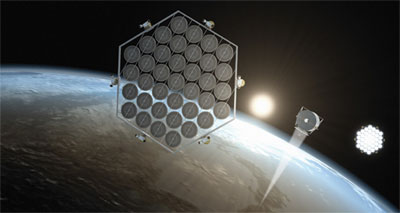Japan has become a world leader on solar and now it’s taking that a big step further – in outer space!
While the country tussles between renewables, coal and nuclear on the ground, it is preparing to put a 1 gigawatt solar array in orbit around 2030 (the size of a nuclear plant). There are many technical challenges to overcome, but the Japan Aerospace Exploration Agency (JAXA) is committed to making it work.
"It would be difficult and expensive, but the payoff would be immense, and not just in economic terms. Throughout human history, the introduction of each new energy source – beginning with firewood, and moving on through coal, oil, gas, and nuclear power-has caused a revolution in our way of living. If humanity truly embraces space-based solar power, a ring of satellites in orbit could provide nearly unlimited energy, ending the biggest conflicts over Earth’s energy resources. As we place more of the machinery of daily life in space, we’ll begin to create a prosperous and peaceful civilization beyond Earth’s surface," says Susumu Sasaki, professor emeritus at JAXA.
Since it was first proposed in 1968, generating solar energy in space has been a dream and JAXA leads the world in pushing it forward. More than many countries, Japan has strong incentives – it has no home-grown fossil fuels and little land for big solar arrays. Thanks to much lower costs and particularly, advances in wireless technology, the concept is finally feasible.
Solar would supply uninterrupted power, collecting sunshine 24/7 from 22,000 miles above the Earth.

Technical issues abound, but JAXA is working through them: how to make the structure light enough; how to send a beam of energy across vast distances and control where it goes without wasting it; how to keep collectors in position and aimed at the sun; and how to build it in space.
The greatest challenge is accomplishing wireless power transmission – aiming a microwave beam across thousands of miles to hit a receiving antenna on the ground!
JAXA has a road map for how to get there, starting with a demonstration on the ground this year – the world’s first high-power, long-range microwave transmission, with all-important beaming control, reports IEEE Spectrum. Next, in 2018, JAXA will demonstrate how to transmit and control those microwaves from space. In 2021 and 2024, it will deploy larger and larger solar collectors into space, culminating with a 1 GW power station in 2031. Later in the decade, they plan to launch a solar station every year.
Advances in wireless power transmission is the game-changing technology that’s makes this possible. It allows antennas to coordinate while they are moving, solving the dilemma of how to precisely beam solar energy over long distances to Earth.
The plan is to use microwaves – which easily penetrate cloud cover without losing much energy. Here’s how it works: Direct current (DC) energy produced by solar panels in space is converted to microwaves and beamed to ground level power stations – a farm of antennas – which collect the energy and convert it back to DC electricity. JAXA says it can do this with a loss of only 20% of energy. To keep the station consistently oriented toward the sun, it is experimenting with two huge mirrors on both ends of the solar array that continuously reflect sunlight onto them.
At 1 GW size, the structure would be about 2 miles long and weigh over 10,000 metric tons!
Japan Not So Clean On the Ground
For now, however, Japan’s government has much less foresight when it comes to the energy used today.
While it was widely expected that Japan’s energy strategy – "Basic Energy Plan" – would present a major policy shift toward renewables and away from nuclear, it doesn’t.
In April, Japan approved an energy strategy that sadly, still prioritizes turning nuclear plants back on and even puts coal on equal footing as an important long term energy source, reports Bloomberg. There are no concrete targets for renewable energy, even though solar is booming. Since its feed-in law began in 2012, over 7.4 GW of solar has been installed.
To keep energy prices stable, Prime Minister Shinzo Abe wants Japan’s coal industry to expand at home and even export it. And that’s happening: utilities consumed a record amount of coal in January; 12% more than the previous year, reports Bloomberg. Since the nuclear meltdown, Japan has been forced to import expensive fossil fuels to fill the gap.
The goal is for Japan to develop and export advanced coal technology, such as gasification – which turns coal into gas – using fuel cells.
"By applying Japan’s most advanced coal technology, the U.S., China and India can reduce a combined 1.5 billion tons of carbon dioxide emissions per year," far above Japan’s total emissions, Japan’s trade minister told parliament, according to Bloomberg.
The technology is already in use in Japan. A 250 megawatt demonstration unit has been deployed for commercial use since the nuclear accident because the country was so desperate for energy. More plants are being added.
"The plan represents nothing but anachronism," Mie Asaoka, who heads the Japanese environmental group, Kiko Network, told Bloomberg.
Because of all this, Japan reneged on its climate targets and emissions are rising.
More details on JAXA’s solar technology in space:

let’s work together for the good of all! the wealthy need a healthy planet to live on as well. no place to hide if the world is polluted. how will they make their huge profits if the “worker bees” have disappeared and no one can buy their products.